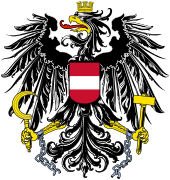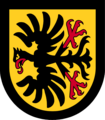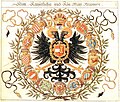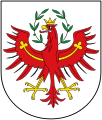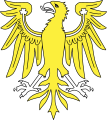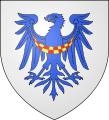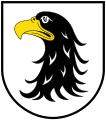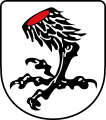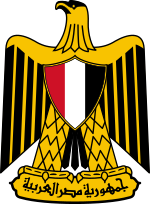Eagle (heraldic animal)
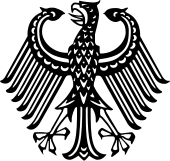
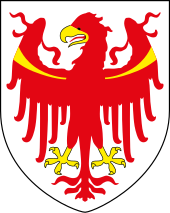
The eagle is a common figure in heraldry and is the most common heraldic animal after the lion .
symbolism
The eagle was the "King of Birds", sometimes also called "king of the air" and messenger of the highest Gods, already in the ancient Near East , the symbol of kings, especially the Achaemenid whose ancestor believed to have been brought up by an eagle. As a symbol of the ruling power, the eagle replaced the vulture, which was widespread in the Egyptian and Persian cultures, as a stately symbol and heraldic animal.
According to Aristotle , the eagle let its young look into the sunlight to test their legitimacy. The bird of prey, so it was obvious, could therefore also measure regions of the sky inaccessible to humans. According to the Epic of Gilgamesh , the first Sumerian king Etana was often associated with the eagle motif and especially with that of the ascension on an eagle. These legend motifs were later transferred to other ruling houses. The eagle consequently became a symbol for the ascent into heaven and especially the apotheosis of great people and rulers (cf. the Roman Divus title), whereby it could stand for the conquest of the earthly as well as the immortality and redemption of the soul .

In Europe, the eagle was introduced as a royal mint and coat of arms by Alexander the Great and then passed over to the kingdoms of his diadochi . Octavian brought it to Rome from Egypt as the imperial coat of arms. When the corpse of an emperor was cremated on the Field of Mars as part of his consecration , an eagle was raised into the sky. This custom is said to go back to an observation made during the cremation of Augustus : Allegedly, an eagle was seen flying from the flame of the pyre into the sky. An example of Roman iconography can be found on the Antoninus Pius column from the year 106 AD. In his dream interpretation from the second century, Artemidor von Daldis reports on the symbolic content of the eagle, which in turn relates to the conceptual fields of power, wealth and fame :
Riding an eagle prophesies death to emperors, the rich and the mighty; for, according to an old custom, painters and visual artists portray such personalities riding on eagles after their death and glorify them with such images. It means a blessing to the poor; they will receive a strong boost and no small amount of support from wealthy patrons, mostly through trips abroad. [...] If a woman dreams that she is giving birth to an eagle, she will give birth to a son who, if he is poor, will become a soldier and will take it to the rank of military leader; for an eagle precedes every army; if he belongs to the middle class, he will become an athlete and make a name for himself; if he is rich, he will rule over many or even become emperor.
Via the imperial cult and the Aquila , the standard of the Roman legions designed with an eagle , the eagle advanced to become a symbol of empire and empire ( imperial eagle ). Also in the military use of the eagle symbol the dream or sign interpretation seems to have played a part (see history of Aquila ). The eagle's identification with Jupiter soon plays a role in its use as a standard , as the image of the eagle with the lightning bolt shows.
Religious ideas
Based on the Ganymede myth , the eagle was associated with the father of gods Zeus among the Greeks , with Jupiter among the Romans and with Odin among the Teutons . In Palmyra, Syria, the eagle was supposedly consecrated to the sun god and as such was able to rejuvenate like the phoenix (for example, by immersing it three times in water). Allegedly the sun is supposed to rejuvenate it, as Wolf Helmhardt von Hohberg explained using the example of the 103rd Psalm : "The eagle, when its feathers become flightless / when the sun's flame rejuvenates and rejuvenates".
In Christian iconography it is used as an attribute of the evangelist John , as a symbol of the prophet Elijah ascended to heaven as well as the risen Christ and his ascension to heaven . The old ruler's virtues of strength, renewal, contemplation, justice and discernment find their continuation here, even if they are occasionally contradicted by the assumption that the eagle tends to sin because of its distant gaze - which seems to disregard the obvious Arrogance.
Forms of the eagle
The forms of the heraldic eagle are many. Even with identical blazon, there can be great differences in the exact design of the eagle, depending on the time of origin, the shape of the shield or the form of the coat of arms and the style and skills of the heraldist or artist. Below are ten examples of a red-armored and red-tongued black eagle looking to the right:
Sitting, standing, soaring and lying eagle
In addition to the traditional eagle, there is the standing and the soaring form with spread wings. The sedentary form with attached wings is extremely rare . There are also isolated representations in a dive .
The free-floating eagle in the secondary coat of arms is a special form .
Standing eagle on the rock, Burgenland
Auffliegender Napoleonic eagle , Brains (Loire-Atlantique)
Lying eagle in the coat of arms of Pratteln
and in Hölstein
Tinging
All heraldic colors and metals can be used to tinge the eagle. Body and flight ( wings , wings ) are generally tinged in the same way. In addition, the weapons - the beck ( beak ) and the fangs ( feet ) - can be made in a different color, as can the tongue .
Depending on the color of the eagle and its ground, a distinction is made between the typical eagles by name, such as the black eagle on gold of the Holy Roman Empire, or the red and silver slaughtered Moravian eagle .
Aigle wields two eagles in mixed up colors .
The beak wasn't particularly emphasized at the beginning. Depictions of the animal with its tongue knocked out appear in coats of arms only after 1400.
Number of heads
Double-headed eagle
The double -headed eagle , a two-headed eagle, is one of the oldest eagle motifs in heraldry. Among other things, it was used by the Holy Roman Empire , the Russian Empire and the Austro-Hungarian Dual Monarchy . Other nations that have the double-headed eagle as their national coat of arms are Albania , Yugoslavia (former), Serbia , Montenegro and Russia . In the case of cities, Arnhem should be mentioned.
Byzantine Empire , relief on the Church of St. George of the Ecumenical Patriarchate of Constantinople in Istanbul
Palaiologists , coat of arms of the ruling family of the Byzantine Empire (1259-1453)
Imperial coat of arms, the coat of arms of the Habsburg hereditary lands arranged around the double-headed imperial eagle
Siebmacher 1605
Eagle with three heads
In the case of a three-headed eagle, as in the Reinmar von Zweter family coat of arms , the Saxons are turned inward and have eagle heads pointing inward at the ends. The actual eagle head follows the heraldic rules. This representation is known from the Große Heidelberger Liederhandschrift. A three-headed eagle in Conrad Grünenberg's coat of arms refers to the coat of arms of the Roman-German emperor .
With the three-headed eagle in the coat of arms of the Waiblingen district , the Saxons are normal, the two outer heads, slightly inclined, sit close to the middle and look outwards.
Coat of arms of the Reinmar von Zweter family
Coat of arms of the district of Waiblingen
Attributes of the eagle

The basic attributes of a heraldic animal are also found in the eagle:
Typical for the eagle are in particular:
- the clover stems and the breast clasp
- Assignment of the wings, especially also with coats of arms
- as well as emblems in the claws:
With laurel wreath
( Tyrol )Eagle with a clover stem
( Prussia , Brandenburg , Silesia , Tyrol, etc.)With breast brace , shaft
( Krain )
Nimbed eagle

The nimbly eagle wears a halo (nimbus) around its head, often in gold, rarely colored otherwise. It is only detectable from the 15th century. Emperor Sigismund is said to have used it in the coat of arms around 1433/37. The St. John's eagle, which is used by Isabella the Catholic as a shield holder and symbolizes John the Evangelist , also had a halo. Both heads of the double-headed eagle are nimbed. In the coat of arms of the Holy Roman Empire, the nimbus of the imperial eagle symbolized the "sacred".
In the 20th century the eagle with a halo was also used by the Austro-Fascist corporate state (Austria) and in the coat of arms of the Spanish state under Francisco Franco .
Shapes of the figure
Half eagle
The eagle can also appear split or divided in the coat of arms .
When it is at the gap, it is split in the middle into two equal parts. The eagle head is excluded and is shown in full. The viewing direction determines the shield side. The half eagle at the gap can be shown to the right or left of the vertical dividing line in the coat of arms. The description half or growing (from a dividing line or a herald's picture) does not apply to this heraldic animal arrangement. The emergence of the half eagle is assumed in the combination of several coats of arms in a shield that emerged in the late Middle Ages and to meet the space requirements.
Split eagle above
Apchat (Puy-de-Dôme)
Young eagle
Designation for eagles shown particularly small in the coat of arms. The name can be found in the blazon of older heraldists . The term is used when there are more than three eagles in the shield or field or when there is a small eagle on a heraldic figure such as a bar for reasons of space. The description is unheraldic, since the proportions must be reduced with a larger number of the heraldic animal. The same applies to the lion and the term young lion is used here.
Mutilated eagle
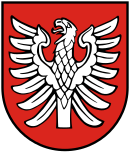
The mutilated eagle is usually shown without fangs .
The eagle without a beak and claws is called Alérion . Example is the coat of arms of Lorraine.
Headless eagle
Headless eagle in the coat of arms of those von der Hoven called Pampus
Headless double-headed eagle in shield and coat of arms of the Mecklenburg noble family Pritzbuer
Headless double-headed eagle in the shield of Rędziny (Powiat Częstochowski)
Parts of the eagle
Often only parts of the eagle are used in coats of arms. So the head, only one catch (leg) or both catches are used for design. Colors correspond to the heraldic rules. If only the upper body is shown in the coat of arms, it can be growing or, if it does not touch the edge of the shield, it can be floating. If only the wings or at least one is attached in or above the coat of arms (upper coat of arms), the heraldist speaks of flight. This flight can be open, closed or a half flight. Beak, tongue, body and tail, but also the claws and wings can always have other colors in the shield. The extinct Moravian noble family of Lomnitz and the Silesian Pelchrzim have an eagle wing in their coat of arms.
A special form of flight is the impeller , one-sided or two-sided. The main use is less in heraldry and more as a badge on service uniforms .
The half flight eagle catch is also known as claw wing . The claw on the wing is often swinging an object, especially a sword .
Eagle head ( Altwiesloch )
three crowned heads ( Labaroche )
Eagle body ( Oberachern )
Eagle catch ( Aindling )
On large feathers, transverse eagle flight facing downwards, with eagle head turned to the left and with a cloverleaf behind ( Heinsheim )
Claw Wings ( Kopacz )
Eagle flight with clover angel ( Lomnice )
Clover angel with eagle flight ( Velké Meziříčí )
Eagle feet under a wolf tang ( Jettingen-Scheppach )
Special types of eagles
Bald eagle
The federal coat of arms of the USA names the bald eagle , in contrast to many other coats of arms, a certain type of eagle .

Phoenix
→ Main article: Phoenix (heraldic animal)
An eagle rising from the ashes, embers or fire is called a phoenix . It is often used in heraldry.
Simorgh
→ Main article: Simorgh
In Avesta and Persian mythology : (Meregho) Saena, Aleh, Alveh, Varghan , Simorgh
Eagle with a different body
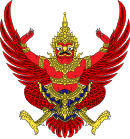
The large coat of arms of the Austro-Hungarian monarchy had an eagle lion as a shield holder on the right . On a lion's body, the front part has been replaced by the upper part of an eagle.
The virgin eagle and the harpy eagle are each a heraldic eagle with the bare torso of a woman. These eagle shapes are to be counted among the mythical creatures .
The eagle man is rarer in heraldry . This fantasy figure is composed of the torso of the eagle and the legs of a man. There is an eagle with armored sword-swinging arm ( armored arm ) in the coat of arms of West Prussia .
Garuda is a hybrid in the Thai coat of arms. The general description of this heraldic animal has been since 1910: human upper body in red with wings of the same color, golden crowned lion-like head, red tail feathers and golden eagle claws on the lower body. In the coat of arms of Indonesia the Garuda eagle is a normal golden eagle.
Wądroże Wielkie (large wall plan) shows both Prussian and Brandenburg eagles. Fish-tailed unicorns are used as shield holders.
Eagle with a different head and tail
Other forms have developed in heraldry. So there is the emblem of the Mark family of Flans the Wolf eagle , an eagle with wolf head and arms of the Counts of Reichenbach Lessonitz an eagle with goat head, goat-headed eagle . Another example is the coat of arms of Schwalmstadt .
Eagle with a wolf's head, Langenorla
Goat head eagle in the coat of arms of Gemünden (Wohra)
Eagle with Maria and child as head in the coat of arms of Lubin
Eagle with dragon tail in the Brig-Glis coat of arms
Examples of eagles by name
Aquila: Roman standard
The Romans had been using it since around 100 BC. The (one-headed) eagle as a symbol of the army and coat of arms and the Aquilæ as a standard of the Roman legions .
Roman Aquila in seal of Castro Pretorio , the XVIII century Rione from Rome
Roman shield sign (around 430),
Notitia Dignitatum
Imperial eagle
→ Main article: Imperial eagle

From the Middle Ages to the 20th century, the imperial or imperial eagle was the symbol for the imperial power - inherited from Roman tradition :
- The ruling families of Ostrom used the eagle and the double-headed eagle.
- In the 12th century, Frederick I Barbarossa made the eagle a coat of arms and a symbol of the Holy Roman Empire . The double-winged eagle, the quaternion eagle , dates back to Emperor Sigismund and the year 1433.
- The Tsardom of Russia by Ivan III. the Great took over the Byzantine two-headed eagle as the “ third Rome ” from 1487. The subsequent Russian Empire under Peter the Great also followed on from this tradition .
After the fall of the Holy Roman Empire in 1806, the eagle went up:
- the empire of Austria , and from 1867 the dual monarchy of Austria-Hungary : the Austrian eagle is a double-headed eagle derived from the quaternion eagle with the coat of arms of the hereditary lands. Today's one-headed federal eagle of Austria was deliberately introduced in 1919 at a distance from the monarchical imperial eagle; it is not derived from this, but from normal coat of arms eagles - while the nimbated double-headed eagle of the corporate state 1934–1938 again made an explicit reference to the Roman-German imperial eagle.
- The German Confederation , founded in 1815, adopted the double-headed imperial eagle as its emblem during the German Revolution in March 1848 .
- In the German Empire , the one-headed imperial eagle was - in addition to the Prussian eagle (since 1701) - also the emblem of the German Empire (1871–1918); The Weimar Republic (1919–1933) also had the imperial eagle in its coat of arms.
At the time of National Socialism (1933–1945) the imperial eagle of the " Third Reich " - with a completely different appearance than the imperial eagle - was associated with the swastika .

Federal eagle
The heraldic animal has been called the federal eagle in Austria since 1920 and in Germany since the end of the Second World War .
The Austrian federal eagle goes back to a design from 1920. During the time of the Austro-Fascist corporate state from 1934 to 1938, it was replaced by a double-headed eagle . After the Anschluss , all of Austria's national insignia were banned. The original eagle has been in use again since 1945. He wears a wall crown (symbol of the bourgeoisie), hammer (symbol of the working class) and sickle (symbol of the peasant class). Broken chains were added to the eagle's claws, symbolizing the regained independence of the state. In Austria, eagles can be seen in the large coat of arms of Vienna ( Vienna coat of arms ) and in the coats of arms of Tyrol ( Tyrolean coat of arms ), Lower Austria ( Lower Austria coat of arms ), Burgenland ( Burgenland coat of arms ) and Upper Austria ( Upper Austrian coat of arms ).
In the federal coat of arms of the Federal Republic of Germany , it has been a state emblem at the federal level since January 20, 1950 . The official form corresponds to the design by Karl-Tobias Schwab (1887–1967), which served as the imperial coat of arms of the Weimar Republic as early as 1928 .
Prussian eagle
|
The Prussian eagle in the coat of arms and flag of Prussia goes back to the German Order . Grand Master Hermann von Salza received the black imperial eagle as a sign of mercy in the gold bull of Rimini , which he then carried in a white shield. The eagle passed from the Teutonic Order in 1525 to the new Duchy of Prussia . After its elevation to kingdom , from 1701 the Prussian eagle wore the initials "FR" ( Fridericus Rex ) on its chest under a royal crown , while it held scepter and orb in its claws. It became the heraldic animal of the state of Prussia , which emerged in the 18th century , although it lost its monarchical symbols as a result of the November Revolution in 1918 . The sports club Preußen Münster also has a corresponding emblem.
Saxony-Anhalt is the only German federal state to show it in its coat of arms (due to the fact that large parts of the state belonged to the Prussian province of Saxony ). The Rhineland Regional Association and the Warmia-Masurian Voivodeship (in the form of 1525) also have the Prussian eagle in their coat of arms. In addition, there is the Gelsenkirchen coat of arms in the version valid until 1928 on a small shield . Today's Saarbrücken district of St. Johann received the Prussian eagle in 1874 on imperial order .
Brandenburg eagle (Märkischer Adler)
The Brandenburgischer Adler | Brandenburg or Märkische Adler has a long heraldic history. The constitution of the state of Brandenburg defines it as the "red Brandenburg eagle on a white field" as the state coat of arms . It is also part of the national flag , and many municipalities also have it there in their respective coats of arms .
Frisian eagle
An eagle provided with a name, which is supposed to document belonging to the Friesland region in many coats of arms , is the Frisian eagle (" Friesian eagle "). He embodies the imperial immediacy and the freedom rights of the Frisians . The term Frisian eagle is not as fixed as the Mainz wheel . A uniform representation is not consistent. A common image is a half-black, red-armored eagle at the gap in gold . It can also be made of silver.
Johannis eagle
The eagle is the attribute of the Evangelist John . As Isabella the Catholic's personal heraldic animal , a St. John's eagle found its way into the coat of arms of the Catholic Kings as a shield holder . The St. John's eagle is one of the few solitary shield holders , alongside the Roman-German imperial eagle and the Austrian eagle .
In the period of Franquism , a black eagle was added to the newly designed coat of arms of the Spanish state in 1939, which was to resemble the St. John's eagle and to tie in with the Catholic Kings . It remained part of the Spanish national coat of arms until 1981.

Wallachian eagle
With Wallachian Adler the Wappenadler of the former is kingdom Romania (Great Romania), respectively.
The eagle was covered with a shield, which showed the coats of arms of individual parts of the country Transylvania , Wallachia , Moldau , Banat , Dobrudscha , and in the middle ( middle shield ) the silver-black quartered Hohenzollern coat of arms . The House of Hohenzollern was represented by Prince Karl von Hohenzollern-Sigmaringen as King Carol I.

Moravian eagle
The Moravian eagle is a gold-crowned white-red (red-white) butted eagle with gold reinforcement in the blue field.
Wenceslas eagle
The Wenceslas Eagle (Flame Eagle) , a black eagle with gold arms, silver feathers on its wings and red flames in a silver field.
Napoleonic eagle
Napoleon I's eagle is a soaring eagle with a bundle of lightning in its claws. The symbol was introduced in 1804 when the title of Emperor of the French was adopted as a national emblem. For him, later also for Napoléon III. , the eagle was also a symbol of the armies in the assumption of the papal promised succession of the Roman Caesars .
Piast eagle
The Piast eagle is named after the Polish ruling family of the Piasts and became their heraldic animal in the early Middle Ages . In coat of arms descriptions his proper name stands for the shortened form of description.
Silesian eagle
See: Eagle in the coat of arms of Silesia and the Silesian probation badge
Eagle saladins
The Eagle of Saladin , according to Sultan Saladin the Great named. It is mainly used as the national coat of arms in Arabic-speaking countries . In this function, he has a breast shield and a banner . Egypt , Iraq , Yemen and the Palestinian Territories use Saladin's eagle as their national emblem. As a heraldic animal, Saladin's eagle rivals the Quraysh falcon in some Arab states .
Chernigov eagle
The princes, descended from the holy Grand Duke Michael von Tschernigow , led the Tschernigow eagle: In the silver field a one-headed black crowned eagle holding a large golden cross lying diagonally above it in its left claw . The city of Chernihiv also uses this eagle.
Chiemseeadler
The former diocese Chiemsee also had a red armored eagle in its coat of arms. This still appears today in various coats of arms in Chiemgau , for example in the coat of arms of the district of Traunstein and that of the municipality of Reit im Winkl (see there).
See also
- Falcon (heraldic animal)
- Griffin (heraldic animal)
- Condor (heraldic animal)
- Free and Imperial Cities # Heraldry
literature
- Walter Leonhard : The great book of heraldic art. Development, elements, motifs, design. 2nd, revised and expanded edition. Georg DW Callway, Munich 1978, ISBN 3-7667-0345-5 .
- Gert Oswald : Lexicon of Heraldry. VEB Bibliographisches Institut, Leipzig 1984.
Web links
Individual evidence
- ↑ So u. a. in Aeschylus , Agamemnon 113; Pindar , Pythia I, 13; ders., Olympia XIII, 30; ders., Isthmia VI, 48; Aristophanes , Die Ritter , 1087. Cf. Eugen or : Adler . In: Paulys Realencyclopadie der classischen Antiquity Science (RE). Volume I, 1, Stuttgart 1893, Col. 371-375.
- ↑ Aeschylus, The Persians , 250; Xenophon , Kyrou paideia VII, 1 and 8; Curtius Rufus , Historiae Alexandri Magni Macedonis III, 3 and 16.
- ↑ Otto Keller : Vultures. In: Paulys Realencyclopadie der classical antiquity. Volume VII, 1 (= 13th half volume), 1910, Col. 931-935.
- ↑ Aristotle, Ἱστορία ζῴων ("History of Animals") IX, 34.
- ^ A b c Hans Biedermann: Knaur's Lexicon of Symbols (= digital library , volume 16). Second edition. Directmedia, Berlin 2000, sv "Adler", p. 34 (= p. 15 of the book version: Droemer Knaur, Munich 1989).
- ↑ Otto Keller: Animals of Classical Antiquity . Olms, Hildesheim 1878, pp. 241, 244 ff.
- ↑ Flavius Josephus , De bello Iudaico III, 6.
- ↑ Herodian , Τῆς μετὰ Μάρκον βασιλείας ἱστορία ("History of the Roman Empire after Marcus Aurelius' death") IV, 2.
- ↑ Cassius Dio , 'Ῥωμαϊκὴ ἱστορία ("Roman History") LVI 42, 3. Further references from Georg Wissowa : Consecratio . In: Paulys Realencyclopadie der classischen Antiquity Science (RE). Volume IV, 1, Stuttgart 1900, Col. 896-902.
- ^ Artemidor von Daldis , Oneirokritika II, 20; translated by Karl Brackertz as Das Traumbuch . Deutscher Taschenbuchverlag, Munich 1979, p. 141 f.
- ↑ Wolfgang Helmhard von Hohberg: The holy crown harp covered with German strings, or, constitution of the whole Psalter of David in German rhyme volumes . Michael and Johann Friedrich Endtern, Nuremberg 1680, p. 369 (first published as the pleasure and artzney garden of the royal prophet David , Regensburg 1675). In the underlying psalm it says: "and you will be young again like an eagle" ( Luther Bible , online text ).
- ^ Walter Leonhard: The great book of heraldic art. 2nd, revised and expanded edition. 1978.
- ↑ a b c Gert Oswald: Lexicon of Heraldry. 1984.
- ↑ Ebrahim Purdawud: The eagle: a sign of Old Iran , compiled by M. Tehrani, In: Borsuye. Journal for Medicine a. Culture 10, 1998, 39, pp. 22-24
- ^ Roman experimental group Legio · XV · Apollinaris · Cohors · I
- ↑ See Jana Leichsenring: State symbols: The federal eagle. In: Current term. No. 83, 2008, December 12, 2008, ZDB -ID 2256061-0 , p. 2, ( online (PDF; 81 kB) ( Memento from January 21, 2015 in the Internet Archive )).
- ^ Jürgen Hartmann: The federal eagle. In: Vierteljahrshefte für Zeitgeschichte . Vol. 56, No. 3, 2008, pp. 495-509, here p. 50, doi: 10.1524 / vfzg.2008.0021 .
- ↑ See illustration of the Reich coat of arms on the panel "German Reich: Wappen I." In: Der große Brockhaus. Handbook of Knowledge. Volume 4: Chi - Dob. 15th, completely revised edition. Brockhaus, Leipzig 1929, plate between p. 648 and 649.
- ↑ Article 4 of the constitution of the state of Brandenburg
- ↑ Balthasar von Campenhausen : Genealogical-Chronological History of the Most Serene House Romanow and its previous parent house. Wilhelm Rein and Company, Leipzig 1805.
